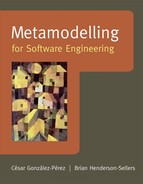6.6 LINKING PROCESS AND PRODUCT ASPECTS
,We have described work products as being either produced or used by the endeavour. This statement must be formalized in some way. In fact, work products can be seen as the “nouns” upon which “verbs” act, the “verbs” being tasks. From this, we can see work products as passive chunks of information and tasks as little processes that operate on them, either reading, creating, modifying or even deleting them. Each time a task acts upon a work product in this fashion, that event is called an action. An action, therefore, can be defined as a usage event performed by a task upon a work product. The concept Action, in fact, acts as a bridge between the process and the product side of the metamodel. More formally, the connection between the process and the product sides of the metamodel is attained by the Action/*Kind powertype pattern (Figure 6.14). An Action/*Kind is a usage event performed in the context of a particular Task/*Kind (process side), and acting upon a particular WorkProduct/*Kind (product side). The ActionKind.Type attribute specifies whether actions of a specific kind create, read, modify or delete the associated work products.

Figure 6.14: Actions and constraints (after [16])
Source: ISO/IEC, 2007, copyright International Organization for standardization, Geneva. Reproduced with permission
ActionKind is also associated to Constraint, which is itself specialized into two subtypes: PreCondition and PostCondition. A precondition is defined as a condition that must hold in order for the associated action to proceed and a postcondition is defined as a condition that is guaranteed to hold after the associated action has been successfully performed [16].
